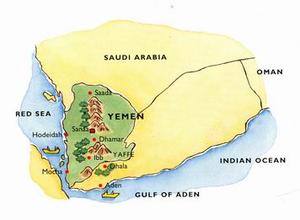Details of coffee producing areas: the development status of coffee industry in Yemen

History of Yemeni Coffee
The origin of mocha coffee
In Yemen, coffee is widely distributed in origin. These coffees have their own characteristics from quality to taste. There are certain differences. However, since these coffees have historically been exported from Yemen Mocha Port and shipped to markets all over the world, they are collectively referred to as Mocha Coffee. Mocha Port is located on the Red Sea coast north of the Strait of Mande, about 100 kilometers away from Aden by land. In addition, because the coffee grown in Ethiopia and other countries in the northeast corner of Africa has the same roots as Yemen coffee, it is also called mocha coffee together.
Yemen was the first country in the world to grow coffee on a large scale and has a long history. Coffee was widely cultivated as a cash crop in Yemen as early as the 6th century AD, when coffee arrived from the Horn of Africa.
International trade in mocha coffee began in the early 16th century, when the Turkish royal family began drinking mocha coffee from Yemen. Mocha coffee is also recorded in the archives of Portugal merchant ships in the 17th century. Portugal sailors at that time, after a long voyage, came to Mocha Port on the Red Sea coast to supply. The chief of the local tribe entertained them with a black drink that the Portugal had never seen before. It had a unique and refreshing flavor and was very popular with the sailors.
At the beginning of the 17th century, the Dutch first established coffee trading companies, coffee began to export from Mocha Port to Europe, and Mocha coffee was very popular in Western European markets from Amsterdam to Paris. For the next 200 years or so, Yemeni mocha coffee almost monopolized the entire European market. With the development of coffee trade, Mocha Port has also rapidly developed from an unknown small fishing village into a new port city.
But from the 19th century onwards, coffee seeds brought home by European sailors were successfully propagated, and countries such as the Netherlands, France, and Portugal began growing coffee in their colonies, gradually outgrowing Yemen in numbers. European powers controlled and monopolized the coffee trade, resulting in the shrinking of coffee exports in Mocha Port. Despite this, Yemen exported about 20,000 tons of coffee annually in the early 20th century. Today, the original site of Mocha Port has long been abandoned, and Yemen's Mocha coffee exports are mainly in the northern port of Hodeida.
(2) Features of Mocha Coffee
Yemenis have been drinking coffee since ancient times, and there is a coffee culture that is very different from the rest of the world. In Yemen, there are many middlemen engaged in coffee acquisition and storage. The new coffee purchased each year is not eager to sell. Coffee farmers also stock coffee at home as a means of saving. What really enters the market is often old coffee beans that have been stored for several years. Due to Yemen's dry climate and lack of rain, the water content of these coffee beans is very low, which also creates a very unique taste of Yemeni coffee.
The Red Sea coastal plain in the west of Yemen is not suitable for coffee cultivation due to climate and soil conditions. Coffee is mainly produced in the western mountainous areas. Mocha coffee grows in the mountains at an altitude of 3000 meters, where the geographical environment is unique, the mountains are rugged, the air is thin, the light is strong, and the moisture comes from rainfall and mountain springs. These conditions create the special aroma and taste of mocha coffee. Local farmers have carved fertile terraces on the slopes. Even today, coffee is grown in these areas in the same way as it was three or four hundred years ago. It is grown entirely manually, without any fertilizers or pesticides, relying on sunlight, rain and unique soil to grow pure Yemeni coffee. In fact, coffee grown in Haiti, Ethiopia and the West Indies is of the same lineage as Yemeni coffee, and many of them are also known as mocha coffee. However, for various reasons, their taste and aroma are very different from mocha coffee produced in Yemen.
Yemeni coffee is also picked and processed entirely by hand. Coffee beans are initially processed by drying and naturally air-drying in the sun. This method is the most primitive and simplest, does not use any machinery, and does not undergo cleaning, so sometimes there are small amounts of sand and small stones in Yemeni coffee beans. At present, only Brazil, Haiti and a few parts of India still use drying method to process coffee beans. The coffee roasting process is also done entirely by hand, and the temperature is entirely dependent on experience and feeling. From planting, picking to roasting, every process is done in the most ancient way, although the coffee beans roasted in this way vary in color, but it is this combination of rough and wild flavor aroma, creating a unique Yemeni mocha coffee, no wonder some people call mocha "the diamond in the crown of Asian coffee."
Yemeni coffee has different names according to its specific origin. There are thirteen main types. Although the taste and aroma are slightly different, they are still collectively called mocha. Among them, the most famous varieties, such as Sanani, Mattari and Harazi, are mainly distributed in the mountains around the capital Sana'a and in the high-altitude mountains between Sana'a and Hodeida. Yemen mocha coffee fruit small, high density, acidity, unique aroma, compared with other famous coffee varieties, sour, malt, nuts, wine, chocolate and other spices mixed flavor, smooth taste, aroma.
2. Coffee Industry Development in Yemen
(i) Total output has continued to decline in recent years
Since 2001, coffee production in Yemen has declined year by year due to various reasons. From 11906 tons in 2001, the annual output dropped to 11608 tons in 2003, 11590 tons in 2004 and 11000 tons in 2008. In recent years, despite rising prices on the international coffee market, Yemen's coffee industry has not thrived, but has shrunk sharply. There are two main reasons for the decline in coffee production.
First, water shortages and soil degradation. Water shortage has become a serious constraint on Yemen's economic and social development. Coffee cultivation depends mainly on rainwater and mountain spring water, lacks irrigation facilities, uses water inefficiently and is greatly affected by climate uncertainty. Soil degradation and erosion are serious and the fertility and productivity of the land are weakening.
Second, farmers gave up coffee and planted Carter instead. Coffee has a long growth cycle, high cost and difficult management, while Carter is easy to plant, short growth period and strong demand, so many farmers change their original coffee fields to Carter. While coffee planting area decreases, Carter planting area increases year by year. The shrinking acreage of coffee cultivation and the continuous decline in production, coupled with Yemen's water shortage and pests, have further aggravated coffee cultivation.
(ii) Low production of high-quality mocha coffee and lack of quality standards
Although Yemen produces more than 10,000 tons of mocha coffee annually, only about 15 - 20 percent of it meets the import standards of developed countries.
Yemen has a long history of coffee cultivation, but the coffee industry has been in an unorganized and extensive stage of development. Because of the scattered planting, basically a workshop decentralized management, which leads to a great difference in the quality of coffee. There are no uniform standards and specifications for coffee bean picking, drying and frying. Hand-processed coffee is easy to change color, high damage rate, and different moisture content. Farmers 'techniques for growing and processing coffee are passed down from generation to generation, inefficient and unscientific, far behind the trends of the international coffee market.
At the same time, Yemen does not currently have identification standards and quality control systems for coffee, and does not test and classify the quality of coffee in accordance with international practices. The lack of effective guarantee of coffee quality is not conducive to entering the market of developed countries. Some illegal businessmen even replace coffee produced in other countries and regions and pretend to be Yemeni mocha coffee after processing. There is still a long way to go to improve the quality of Yemeni coffee and improve its market competitiveness.
(iii) Coffee exports shrink
Coffee used to rank high among Yemen's export commodities, but its status as a major export commodity declined year by year with the development of large-scale oil exploration and fishing. from the top five ten years ago, it has dropped to 23 or 24 in recent years.
Yemeni coffee production has declined for four consecutive years since 2001, and coffee exports have suffered severely along with the decline in production.
In 2005, Yemen's Ministry of Agriculture and Irrigation proposed a plan to plant 1 million coffee trees in one year. With the strong support of Yemen's Ministry of Agriculture and Irrigation, the government has increased investment in coffee cultivation, actively encouraged farmers to plant coffee trees, and adopted a series of promotion measures, including the construction of water conservancy facilities and the promotion of planting technology, hoping to develop coffee production and earn foreign exchange for export.
As a result of these measures, coffee production and exports have recovered and developed to a certain extent in recent years. Table 1 shows statistics on exports of green coffee beans. As can be seen from the table, since 2006, the annual decline in the export of raw coffee beans has been curbed and began to pick up. The export volume in 2007 has approached the level of 2003. Overall, however, coffee remains underrepresented in Yemen's export commodity mix and does not realize the full strength and potential of its coffee brand.
(4) Exports are dominated by raw materials and semi-finished products, and the export structure is unreasonable
More than 90% of Yemen's coffee exports are coffee beans, and the proportion of refined coffee powder does not exceed 10%. Yemen's coffee exports are dominated by unprocessed and primary processed products, and its deep processing capacity is not strong, while the value of deep processing and its added value are much greater than those of primary processed products, which seriously affects the overall quality and income of coffee trade.
(5) Lack of modern national enterprises and sales channels
The main body of coffee production and management in Yemen is extremely scattered farmers, lacking circulation enterprises that can organize farmers and have management and sales strength. A few ethnic coffee enterprises are small in scale, lack competitiveness and do not have excellent brands. This decentralized backward situation can not form economies of scale, more conducive to reducing costs and rational allocation of resources, seriously restricting the development of coffee industry.
III. Prospects for Yemen's coffee industry
According to the International Coffee Organization (ICO) forecast, affected by the international financial crisis, as western developed international consumers began to cut back on spending, demand for high-end coffee has begun to be suppressed, while high-quality and low-cost coffee of origin is still in short supply. If Yemen coffee can seize the opportunity, fully publicize its original ecological pollution-free characteristics, and give full play to the advantages of high quality and low price, there is still room for upward development.
Yemen should start with supporting its coffee enterprises, establish a more market-oriented coffee circulation and sales system, improve coffee production technology, improve and stabilize coffee quality, improve product appearance packaging, strengthen advertising, enhance brand image, and take the road of high added value and brand management.
Yemeni mocha coffee can only fully realize its value if it leaves its origin and opens up international markets. This means that Yemen's coffee industry must look at the international market and take exports as its goal and orientation in order to usher in greater development on the basis of being bigger and stronger based on its own country.
Source: Network
Important Notice :
前街咖啡 FrontStreet Coffee has moved to new addredd:
FrontStreet Coffee Address: 315,Donghua East Road,GuangZhou
Tel:020 38364473
- Prev

Coffee knowledge: introduction to the anatomy of coffee fruit and the grade of honey treatment
1. Coffee fruit anatomy map Coffee fruit is divided into five layers, as shown in the figure: these five layers are: 1. Skin/Pulp: the outermost layer of coffee beans is covered with berry-like skin and pulp. In addition to the natural sun method, coffee beans treated by other methods must remove the skin and flesh within a few hours after picking. Similar to it is the cherry we often eat, but different
- Next

Introduction of coffee producing areas: the location of geographical markers has a great influence on Karumbia coffee beans.
In 1959, only 4% of Americans knew about Colombian coffee, and now 92% do. The credit for bringing Colombian coffee to the world is the Colombian National Federation of Coffee growers. On the occasion of the World Geographical indications Congress in Beijing, the reporter interviewed Luis Fernando Sambel, president of the International Association of Geographical indications, who is also a national coffee grower in Colombia.
Related
- What is the meaning of lactic acid fermentation with coffee bean treatment?
- How to judge the state of foam by sound?
- How does the latte pull out the unicorn pattern? Come to get for a little trick to improve the flower pull!
- Will flower pulling affect the taste of the latte?
- Do you know the history of coffee?
- The difference between honey treatment and sun washing what is raisin honey treatment?
- What kind of milk can a novice use to make coffee foam to keep the foam longer? The correct method and skills of milking tutorial sharing
- Why do washed coffee beans taste sour? Flavor characteristics of washed Coffee
- Introduction to the skill of how to practice the size and height of water injection around the circle of hand-brewed coffee
- How do beginners practice coffee flower drawing from scratch?

